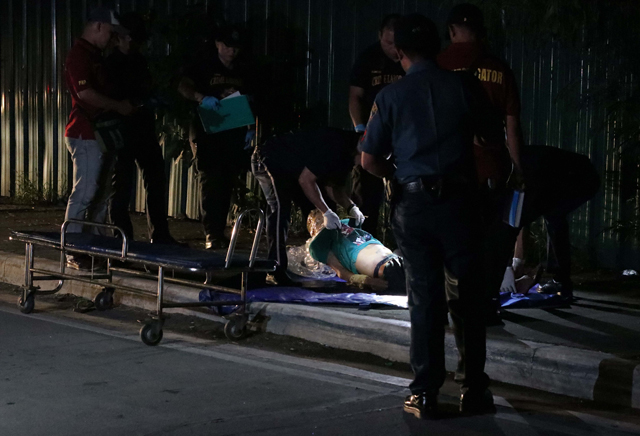Media Gives Bloodless Tokhang a Free Ride

Members of the police retrieve the body of the victim of an alleged drug-related killing along Diokno Boulevard, Pasay City on November 14, 2016. | Photo by Aly Samonte
PHILIPPINE NATIONAL Police (PNP) Chief Director General Ronald “Bato” dela Rosa said it would be a “bloodless” war this time, as government mounted the third relaunch of its main campaign against illegal drugs, Oplan Tokhang, on January 29. It seemed then that there was something new in these announcements.
In the new Oplan Tokhang, he said policemen will be selected, trained and will strictly follow new guidelines to assure the observance of due process. CMFR noted several media organizations that gave detailed reports about the new guidelines (See: “Tokhang Re-launched: What the Public Needs to Know”).
Since then, news accounts have reported drug-related killings.
On February 3, the Manila Bulletin reported the killing of an alleged drug pusher in a gunfight during a buy-bust operation in Tondo, Manila (“Alleged drug pusher shot dead after initiating gunfight with cops”).
A February 21 report from Inquirer.net noted that a suspected drug pusher, who was included in the top 10 police watch list, was killed in an alleged shootout with policemen in Tiaong town, Quezon province (“Suspected top drug pusher slain in Quezon”).
The reports on more recent killings made no reference at all to the PNP’s pledge for a nonviolent campaign.
PhilStar.com reported on February 5 the PNP’s explanation of the deaths as part of another operation. PNP Spokesman Chief Superintendent John Bulalacao during the regular Monday press conference explained that the deaths are not part of Oplan Tokhang which is only done from Monday to Friday, 8 a.m. to 5 p.m. (“No Tokhang deaths so far, PNP clarifies”). The killings occurred during sting operations conducted by the police against high-value suspects. National Capital Region Police Office (NCRPO) Chief Director Oscar Albayalde said that the campaign has two goals and operates on two levels. Tokhang aims to reduce the demand for illegal drugs while “drug stings” cut down the supply. He added that most of the policemen are armed with search warrants when they conduct the latter.
CNNPhilippines.com also noted on February 4 the distinction between Oplan Tokhang and sting operations, with the former serving as the lower barrel of the administration’s anti-drug campaign: Oplan Double Barrel. The upper barrel are police sting operations focusing on high-value targets (“No complaints from relaunched ‘Tokhang’ – PNP”).
CMFR earlier provided background, describing Oplan Double Barrel as “a two-pronged” approach: Project Tokhang and Project HVT (high value target), and noted that the media was not differentiating the activities of either barrel (See: “Winning Against Illegal Drugs? Localities declaring ‘drug-free’ status”). The press, following the language of the police, took to calling the two levels of the campaign with one name: Tokhang.
Media did not question what has changed. Are there stricter guidelines for sting operations and raids against HVTs to assure less violence? If the operations are for HVTs, why are petty drug peddlers among the victims? Media should also ask about what is meant by “sting” operations and what falls under this category.
The media, which carried Dela Rosa’s promise for a bloodless campaign, was taken for a ride. The Tokhang relaunch was nothing new. Tokhang was always intended as a community-based effort. It was the other barrel that was the source of so much killing. But that “barrel” remains reckless in its approach toward saving lives.
The media should at least point out that very little seems to have changed. The press should keep as tight a watch over the number of drug suspects killed and the circumstances of their deaths.
Leave a Reply